|
|
|
|
#1
|
||||
|
||||
|
If all the cards were of equal value theoretically, lumping all the grades and cards together would have more statistical validity.
This is a nice overview and interesting, but may be flawed from a pure statistical point of view. Without getting into p values and questioning the percentage of and which hall of famers are in each group, incorrect conclusions could be inferred from the numbers. In other words there could be some apples and oranges issues contained within the data presented. For example, if the higher valued cards are more likely to have been graded by PSA, then comparing average card prices by grade between SGC and PSA could be due to either higher prices for one company's slabs for the same card or a different distribution of cards within the subset and not a real difference in price for the same card. In no way should this be interpreted as criticism of the work in terms of accuracy, but merely a caution to members in terms of drawing too many conclusions from the data presented. I would add that I am not a statistician capable of validating presentations of this type, but merely a math guy who knows that numbers can be manipulated to validate assumed conclusions.
__________________
RAUCOUS SPORTS CARD FORUM MEMBER AND MONSTER FATHER. GOOD FOR THE HOBBY AND THE FORUM WITH A VAULT IN AN UNDISCLOSED LOCATION FILLED WITH WORTHLESS NON-FUNGIBLES 274/1000 Monster Number |
|
#2
|
||||
|
||||
|
Thanks for the informative post, OP. It was interesting to see what it would cost to put together a T-206 set minus the Big Four in various grades.
|
|
#3
|
||||
|
||||
|
+1 thank you for the work and for sharing it. I think any sampling of this scale will probably have some holes here or there, but it was really interesting and informative to look over your data. I'm about 50/50 between PSA and SGC, but don't generally care which holder it comes in.
|
|
#4
|
|||
|
|||
|
Nothing against the OPís efforts a neat read. However I think you will find buying the entire T206 set minus the big four in EX condition from either company for 100-120k something that you would be hard pressed to do. Regardless if you buy it finished or card by card I think you will find that an all EX set will be much, much more. In fact if anyone has an all EX set minus the big 4 I will gladly pay the above prices.
|
|
#5
|
||||
|
||||
|
Quote:

|
|
#6
|
|||
|
|||
|
No shot at you Eddie just more of warning to not pull that IRA money too soon for this EX set for 100k. Know the feeling on prices you could offer certain cards for 75% off and I still couldnít afford them.

|
|
#7
|
||||
|
||||
|
Hey guys,
I wanted to further explore the subject and work with the data a bit more. What I found was pretty interesting. I agree with a lot of the feedback. It's unrealistic to group "commons" with "stars" to arrive at an average price. I decided to split the two and look at their numbers separately. First, I had to decide what constituted a "star" from a statistical stand point - I figured the easiest way would be by taking the 50 most expensive cards out, and designating the remaining as "commons". NOTE: While some might argue against this approach it actually was an effective way of keeping the hard to find commons while filtering out the lower dollar Hall of Famers. Now, just for the sake of it, here are the 50 most expensive T206 cards in PSA 4 (I chose this measure because it contained the most data from VCP). These are the cards I consider "stars" for the purpose of this discussion: NOTE: I want to keep "stars" in quotations because I know that some people would argue this list. 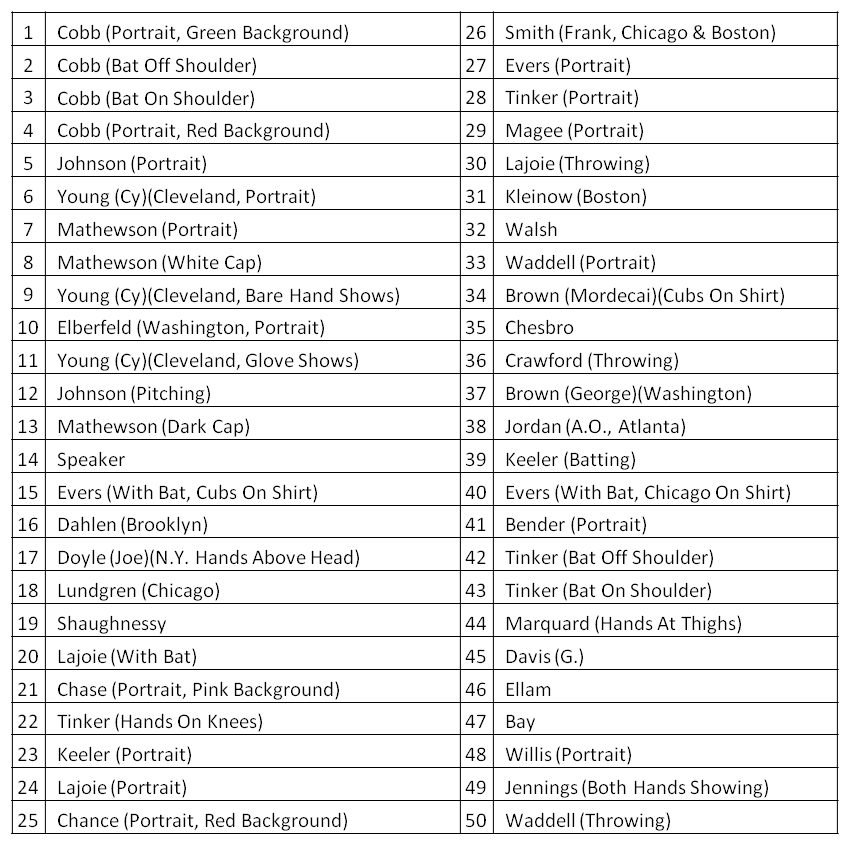 Once I had my "stars" I found the average prices in each grade (2-7) for PSA and SGC. 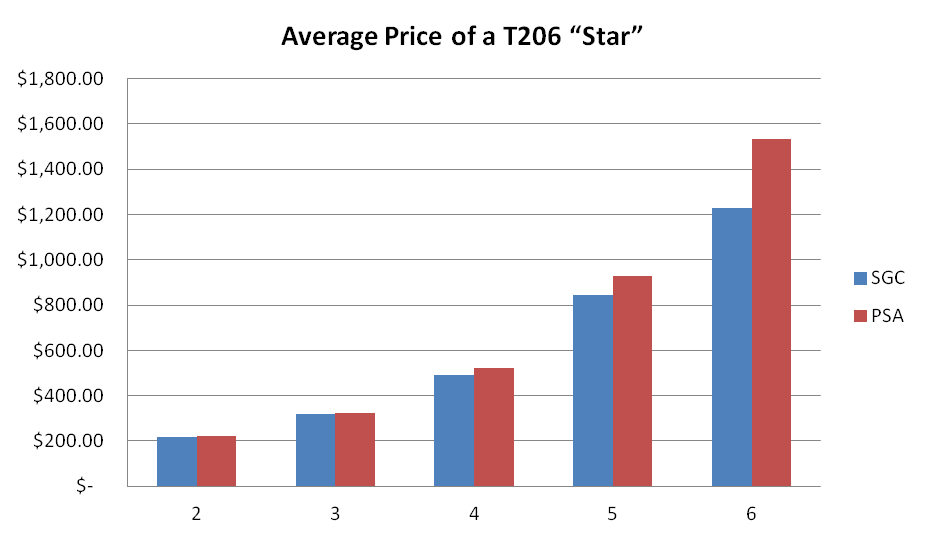 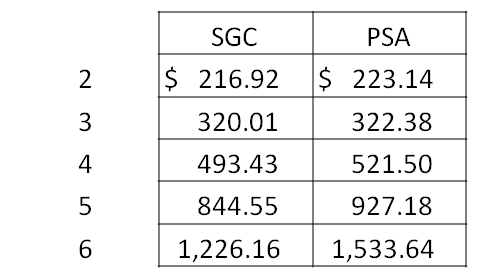 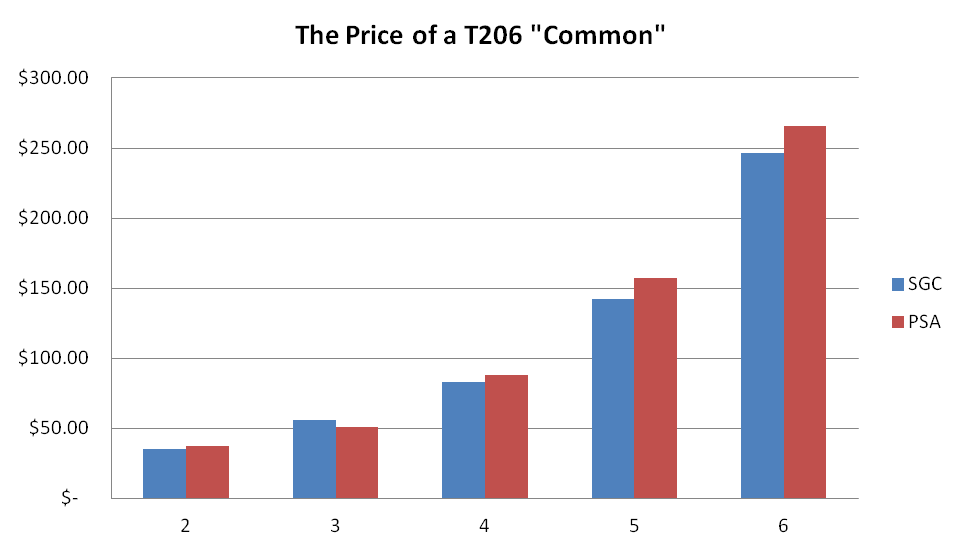 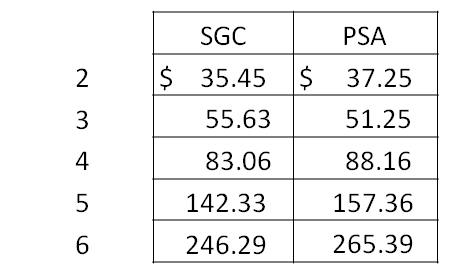 The results were pretty surprising in two regards: SGC commons are virtually identical in price compared to their PSA counterparts and low grade SGC cards can run for a premium over PSA. Another observation (that may not surprise many) was that high grade PSA stars carry a premium over SGC. I think this is in large due to registry fanatics and those "investor" type collectors I talked about in my previous post. However, I am much more interested in the "commons". Why would SGC 3 "commons" demand a premium over PSA 3's? This is especially interesting because there is a huge concentration of SGC 3's on the market: (From my previous post) 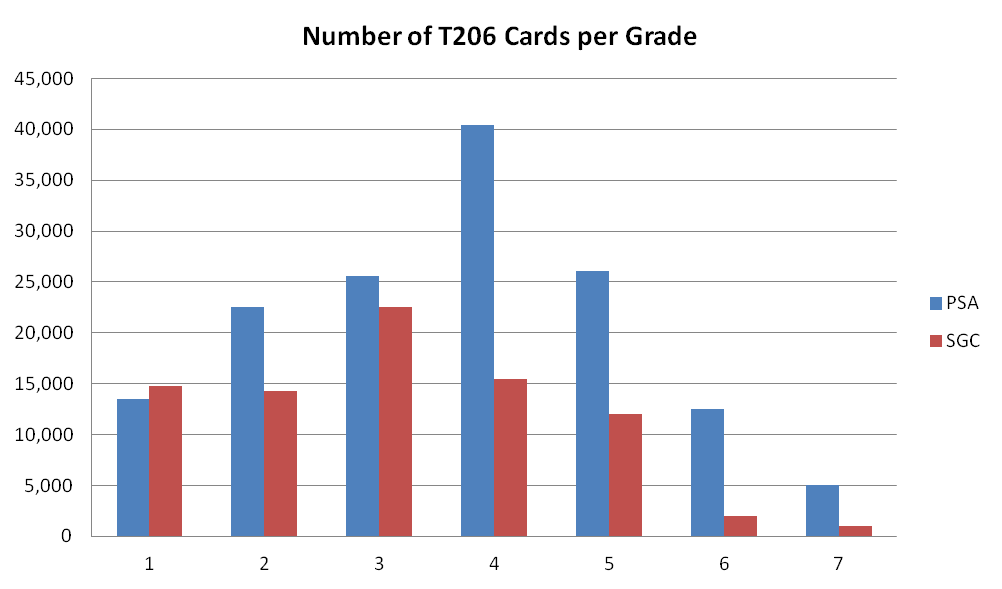 It seems as though SGC 3's are readily available and seemingly "high pop", so why would it be the only condition to carry a premium over PSA? You would think that the condition that has the highest supply would command a lower price, but this has not been the case across the board! PSA 6's and 7's are far more readily available than SGC, but they can carry a HUGE premium. Why is it that the conditions with the highest populations carry a premium?? Well, I believe a premium is established to the TPG company with the more readily accessible commons. It caters to the set collectors in us all, and set collectors are the driving force in establishing a value for commons. Think about it, there are very few Shad Berry collectors (not to pick on Shad Berry), and if there are any Shad Berry collectors, I doubt that there would be enough of them to influence the average price of a Shad Berry card. The collectors who purchase these low grade commons are doing so to "tackle the monster." They're trying to build sets on a budget with decent eye appeal. But why SGC 3's?? Like I said in my previous post, SGC caters to the collector. Low grade tobacco cards look better in SGC holders. I know that this will be debated, but I believe the premium for SGC 3's is, in part, driven by the eye appeal of the case. This solely applies to low grade cards. The black background can really make a fugly card "pop". Personally, I prefer the look of high grade cards in PSA holders compared to SGC, but for low grade cards, SGC wins hands down. But why the premium? Well, set collectors love uniformity. Let's face it, we are obsessive people. While I know many of you have sets with a combination of SGC, PSA and raw cards, I know most of us prefer one TPG company or another. The reason PSA 6's carry a premium is because a collector can more easily assemble a mid grade set using PSA cards over SGC. SGC can carry a premium because it is just as easy to assemble a low grade set using SGC cards as it is with PSA. If I were to apply this to every pre-war set I guarantee we would see the same trends. Whichever TPG company has the more readily accessible commons will carry a premium. Essentially, the supply of the cards determines the demand and the demand then determines the price. Interesting stuff 
|
|
#8
|
|||
|
|||
|
Interesting stuff. I've heard that sgc leans on the VG grade. They assign the grade more then vgex. Maybe the premium you are seeing is from people paying more for nicer looking VG cards, or maybe because there's a guy out there buying an all sgc 40 set right now

|
|
#9
|
||||
|
||||
|
Loved the analysis. I go for SGC because of their puritanical grading. PSA is too lenient and sloppy in their grading. I will purchase PSA cards only to crack them out and send to SGC for a true grading.
|
|
#10
|
||||
|
||||
|
Nice work. How about a comparison of the truly "elite star"cards versus the rest of the star cards? Lets say Cobb, Young, Johnson, and Mathewson vs the rest of the "star" cards. My guess here is that the elite "star" cards would favor PSA and that collectors would be more willing to chose between PSA and SGC with the other star cards. It could also account for a different type of collector. The T206 collector vs the collector who wants lets say a Cobb card for their collection. I think it would be interesting to see how the numbers align with perceptions.
Thanks again for all the work and an interesting thread. 
|
|
#11
|
|||
|
|||
|
I think this analysis is spot-on. I would just add that the trend toward PSA collectors at the higher end of the grading spectrum and SGC collectors at the lower end of the grading spectrum is self-reinforcing since supply begets more supply. Guys who collect the set in PSA 5 buy EX-looking raw commons and send them to PSA for slabbing and adding to their sets. On the other hand, guys who collect the set in SGC 3 buy VG-looking raw commons and send them to SGC for slabbing and adding to their sets. Hence ever-increasing supply of PSA 5s relative to SGC 5s and ever-increasing supply of SGC 3s relative to PSA 3s should drive more and more T206 EX collectors to PSA and more and more T206 VG collectors to SGC.
Last edited by sreader3; 02-20-2013 at 02:03 PM. |
 |
|
|